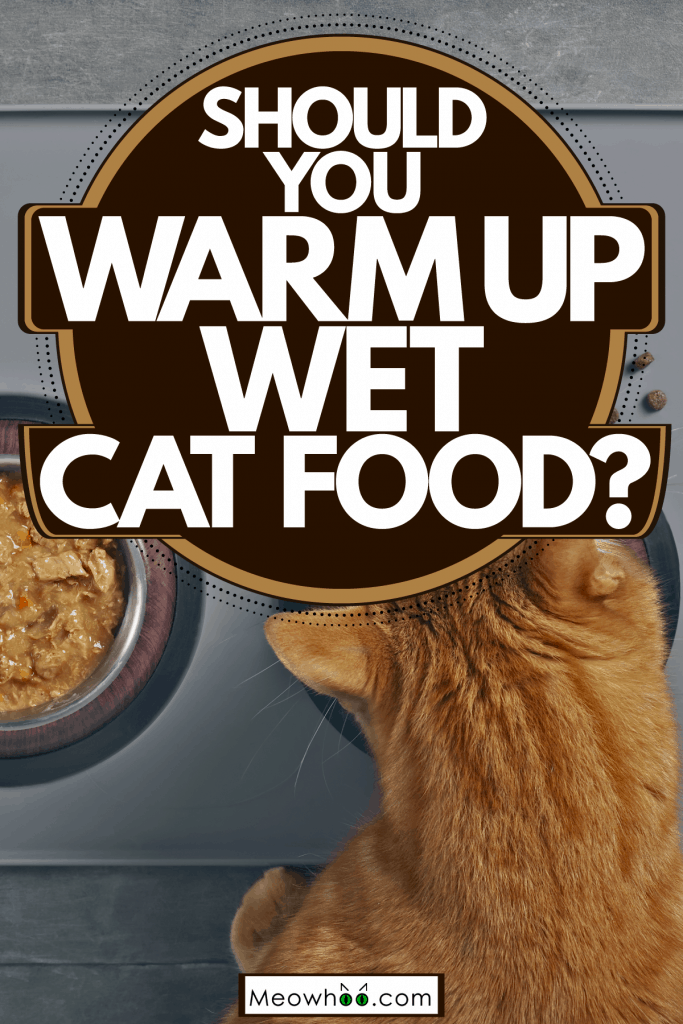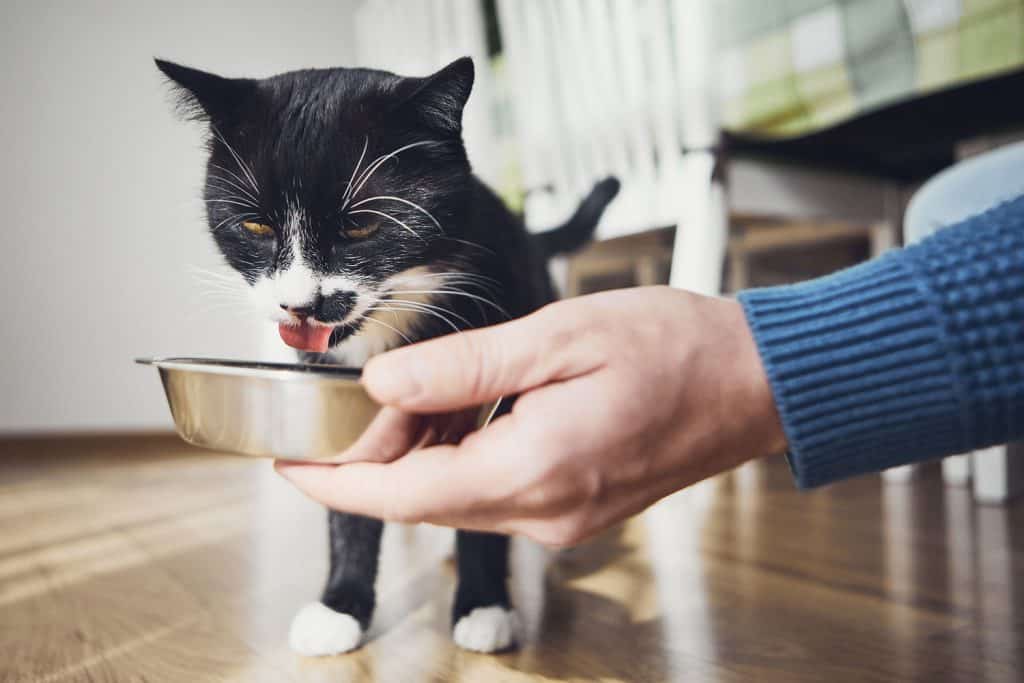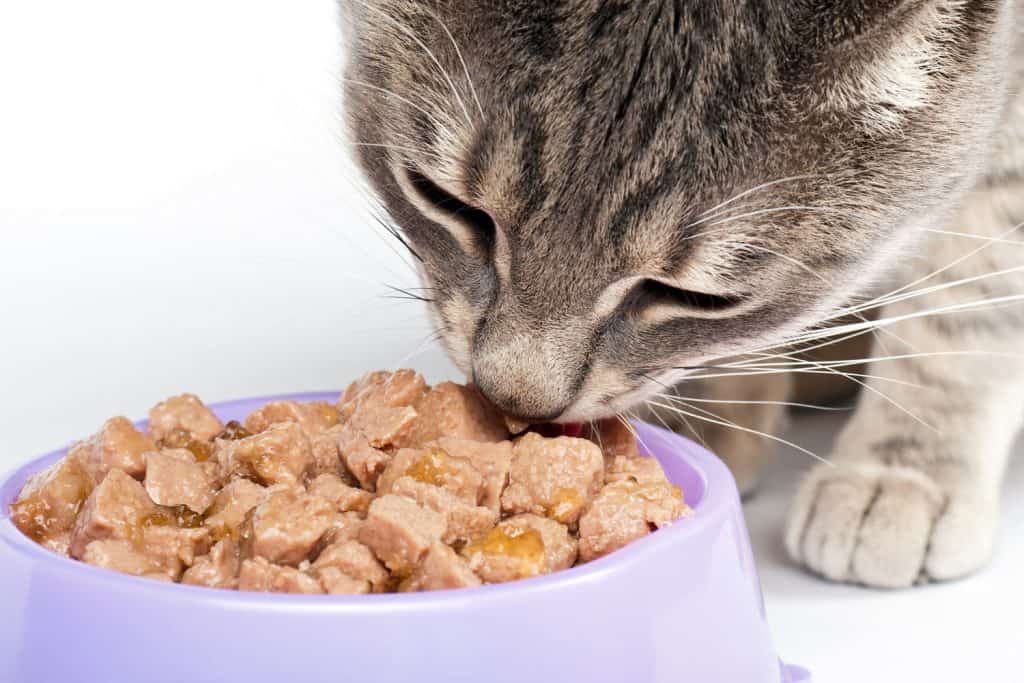Many cats are picky eaters and won’t hesitate to turn down food if served straight from the refrigerator. Your pets prefer eating food when warmed or at room temperature. But how can you feed your cat warmed-up wet food safely? We consulted pet experts to let you know.
It’s not ideal to warm wet cat food in the microwave for extended periods. Otherwise, the appliance can dry the food significantly, inhibiting your pet from consuming the recommended daily amount of moisture. Still, you can warm the cat food in the microwave, but only do it for a few seconds.
Following the proper warming process can help safeguard the nutrients in the wet cat food. Also, continue reading to know the answers to some of the frequently asked questions relevant to warming up wet cat food.

Should You Warm Up Refrigerated Cat Food?
It’s ok to warm up refrigerated cat food, especially if your pet is a picky eater. However, heating wet cat food can reduce its moisture content, decreasing the product’s nutritional value. Warming the food slightly can help prevent this issue.
Is It Okay to Microwave Wet Cat Food?
You can microwave wet cat food, but only for a few seconds. The appliance radiates microwaves, which reflect around the device’s walls. These electromagnetic waves react to moisture, heating things like wet cat food quickly. Therefore, heating wet cat food for extended periods can dehydrate it, reducing its nutritional properties.
Also, microwaves aren’t reliable in heating foods evenly. According to a 2018 study, microwaves act differently when interacting with different objects. Additionally, these electromagnetic waves don’t travel far, causing food to be hot on the outside but cold at its core. Therefore, cold wet cat food won’t generate even warming when placed inside a microwave. Once your cat’s tongue hits that cold area, the animal may not finish the food.
How Do You Warm Up Wet Cat Food?

Following the correct procedures for warming wet cat food is important to avoid reducing your pets' nutrition intake. Certain techniques exist to help you heat your cat's food without reducing its nutritional value significantly. The following are the steps for these methods.
Using the Microwave
- Remove the food from the metal can and place it in your pet’s bowl.
- Place the bowl in the microwave and set it to a low heat setting.
- Set the timer to 8 seconds at most.
Using Ceramic Saucers
- Heat water and place it in a ceramic saucer.
- Open the canned wet cat food and place it in the saucer with the hot water.
- Wait for 1 to 2 minutes before serving.
Take note that putting metal objects in the microwave can cause the microwaves to behave violently, increasing temperatures significantly. If left unchecked, the temperatures can be so high that it can melt metal.
How Long are Canned Goods Safe in the Heat?
Opened canned goods are safe for one hour in outside temperatures 90 degrees Fahrenheit (32.22 degrees Celsius) or higher. On the other hand, sealed canned goods can survive outside temperatures over 140 degrees Fahrenheit (60 degrees Celsius) for two hours.
However, canned food spoilage risks increase significantly when exposed to temperatures over 100 degrees Fahrenheit (37.78 degrees Celsius), regardless of the state of the container’s seal. The acid or moisture content of canned foods can adversely react with the high temperatures when exposed for extended periods, causing nutrient breakdown.
Do Cats Like Their Food Cold or Warm?

Cats generally don’t like food straight from the refrigerator. Felines prefer food a bit warm or at room temperature. It’s because these temperatures are closer to their bodies’ body heat. Additionally, warm cat food satisfies your pets’ predatory nature by consuming food that feels like fresh prey.
Is Cold Wet Cat Food Bad for Cats?
Cold, wet cat food isn’t bad for cats. If your cat has no issues with eating cold food, the feline shouldn’t acquire health problems from consuming it. However, your cat will most likely ignore the food upon feeling that it’s not warm. Take a few moments to make the extra effort in warming your cat’s food. That way, the animal should consume their daily nutritional requirements.
Can You Leave Wet Cat Food Out Overnight?
It’s not ideal to leave wet cat food out overnight. The moisture content can invite harmful airborne bacteria to contaminate the food. Consuming contaminated cat food can cause health issues for your pet, such as headaches, nausea, and digestive problems.
Furthermore, leaving exposed wet cat food at room temperature overnight will promote excellent conditions for mold growth. Thankfully, it’s relatively easy to spot molds on surfaces. Look for discolorations of seemingly unknown origins on the food’s surface. If so, don’t feed your cat the spoiled food. Throw the ruined food in the trash instead.
Why do Cats Need Moisture?
Cats aren’t fond of moisture but the animals still need it as part of their healthy diets. Heating wet cat food can dehydrate it, which can reduce its nutritional traits. Feeding your pets wet cat food provides different advantages that help boost their well-being.
Proper Hydration
Many cats have low thirst drives. If your feline goes up to its water bowl, there’s a high chance that your pet will only drink water to remove the dryness from the throat. In other words, your cat won’t drink water to satisfy thirst. Eating wet cat food can help safeguard your cat's hydration and reduce the risks of health issues like heat stroke and trauma.
Active Lifestyle
Like humans, cats become lazy or lethargic without proper hydration. Feeding felines wet cat food can help improve and secure their active lifestyle. It could also lead to other health benefits, such as maintaining a healthy weight. Plus, wet cat food contains sufficient amounts of protein required to fuel the animal’s bodily processes.
Lower Risks of Cardiovascular Issues
As per a 2007 study, researchers found that hydration status can affect cardiovascular status in cats. Without sufficient amounts of moisture, blood will thicken in a feline’s body. This scenario will cause blood to flow inefficiently, leading to a high risk of cardiovascular issues like elevated heart rates and heart attacks.
Reduced Unwanted Water-Seeking Behavior
Your cat will seek water from unhealthy places if it wants more moisture. Some examples of these locations are street puddles, plant dishes, and toilet bowls. These areas harbor harmful substances that can put your pet at a high risk of contracting illnesses.
Improved Skin Elasticity
A cat’s healthy skin is pliable and soft. Without adequate amounts of water, the feline’s skin becomes dry and firm. This occurrence is skin turgor and happens because of the cat’s skin’s inability to sustain a normal shape. This issue will also put the pet’s skin at a higher than average risk of bruises, cuts, and other injuries. With wet cat food, your pet should have enough moisture to reduce the risks of skin turgor.
Final Words
Cats tend to enjoy warmed-up wet cat food. Felines will most likely ignore cold food, especially if it came straight out of the refrigerator. However, warming wet food in the microwave for extended periods isn’t ideal because the electromagnetic waves can reduce the product’s moisture content significantly. Instead, set the microwave at a low heat setting while warming the cat food for only a few seconds. That way, you won’t reduce your pet’s daily moisture intake.
Some elements on this page may have been created by our team using advanced AI to provide you with top-notch cat inspired ideas. Read more about our AI Content Policy.

Very informative. I especially liked that the article included an alternative to microwave heating unknown to me.
Thanks for the tip. I’ve been microwaving my kitty’s food for about 7 seconds. Now I know why she hasn’t been eating all of it. She ate the warm section, but not the rest. This morning I gave her food a good warm up and she ate just about all of it!!!
Cat food can be heated in a healthier way than the microwave, although we tend to want the quickest easiest way for everything. Is a minute too long?
I avoided using the microwave by heating water in my electric kettle, and pouring a small amount over the food in my cat’s saucer. If you don’t have an electric kettle, you can run the faucet water til it gets hot, although you’d be wasting a precious limited resource. I use a Capresso water kettle. It’s made of German glass which has a protective base to prevent breakage, and is beautifully designed. There are other cheaper brands, most of which are some form of plastic. Heating anything in plastic can cause chemicals to leach into water and food. I’ve used my Capresso kettle for various other things, especially with our water shortage in California. I heat water to wash a few dishes, so I don’t have to waste water while it gets hot from the faucet. The best part is that it’s so FAST you won’t believe it.